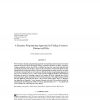Free Online Productivity Tools
i2Speak
i2Symbol
i2OCR
iTex2Img
iWeb2Print
iWeb2Shot
i2Type
iPdf2Split
iPdf2Merge
i2Bopomofo
i2Arabic
i2Style
i2Image
i2PDF
iLatex2Rtf
Sci2ools
113
Voted
JCB
2007
2007
A Dynamic Programming Approach for Finding Common Patterns in RNAs
We developed a dynamic programming approach of computing common sequence structure patterns among two RNAs given their primary sequences and their secondary structures. Common patterns between two RNAs are defined to share the same local sequential and structural properties. The locality is based on the connections of nucleotides given by their phosphodiester and hydrogen bonds. The idea of interpreting secondary structures as chains of structure elements leads us to develop an efficient dynamic programming approach in time O(nm) and space O(nm), where n and m are the lengths of the RNAs. The biological motivation is given by detecting common, local regions of RNAs, although they do not necessarily share global sequential and structural properties. This might happen if RNAs fold into different structures but share a lot of local, stable regions. Here, we illustrate our algorithm on Hepatitis C virus internal ribosome entry sites. Our method is useful for detecting and describing loc...
Related Content
| Added | 15 Dec 2010 |
| Updated | 15 Dec 2010 |
| Type | Journal |
| Year | 2007 |
| Where | JCB |
| Authors | Sven Siebert, Rolf Backofen |
Comments (0)

